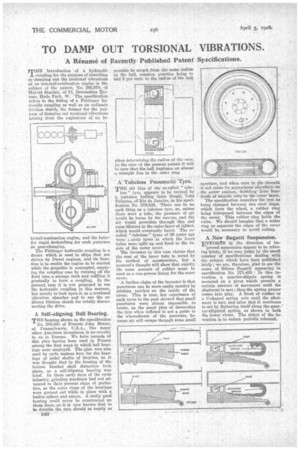TO DAMP OUT TORSIONAL VIBRATIONS.
Page 74

If you've noticed an error in this article please click here to report it so we can fix it.
A Résumé of Recently Published Patent Specifications.
,r11HE introduction of a hydraulic
coupling for the purpose of absorbing or damping out the torsional vibrations of an internal-combustion engine is the subject of the patent, 'No. 285,970, of 'Harold Sinclair, of 11, Devonshire Terrace, Hyde Park, W. The specifiCation refers to the fitting of a Flittinger hydraulic coupling as -well as an ordinary friction clutch, the former for the purpose of damping out torsional vibrations raising' from the explosions of en in
ternal-cembustion engine, and the latte for rapid declutching for such purposes as gear-changing.
The Fottinger hydraulic coupling is a device which is used in ships that are
• driven by Diesel engines, and its function is to enable the engine to be started while the propeller is uncoupled, emptying the coupling case by running off the fluid into a storage tank and refilling it gradually to form a coupling. In the present case it is not proposed to use the hydraulic coupling in this manner, but merely to look upon it as a torsional Vibration absorber and to use the ordinary friction clutch for totally disconnecting the drive.
A Self-aligning Ball Bearing.
THE bearing shown in the specification
No. 283,88.; of Francis John Braun, of Pennsylvania, U.S.A., like many other American inventions, is no novelty to us in Europe. We have records of this plan having been used in France -among the first ways in which ball bearings were employed. The plan was also used by cycle makers here for the bearings of pedal shafts of bicycles, as it was thought that in the brazing of the bottom bracket shell distortion took place, so a self-aligning bearing was tried. In those early days of the cycle industry, grinding machines had not adfenced to their present stage of perfection, so the outer rings of the bearings were ground out while in place with a feaden sphere and emery, A really good bearing could never be constructed on those lines, as it is now known that to be durable the race should as nearly as
B40 ' possible be struck from the same radius as the ball, common practice Icing to 'add 5 per cent. to the radius of the ball when detei mining the radius of the race. In the case of the present patent it will be seen that the ball impinges on almest a straight line in the outer ring.
A Tubeless PneumatiC. Tyre.. THE old idea of the.' so-caIled " tube
less" tyre, appears to be revived by Patentee hailing from Brazil, 'Luis Tubarao, of Rio de Uneiro, In his specification No. 279;8;39. There can be no such thing as a tubeless tyre, as, unless there were a tube, the pressure of air would be borne by the canvas, and the air would percolate through this and raise-blisters in the outer layer of rithber, which would eventually burst. The socalled " tubeless " tyres of'30 yeers ago were iserely tyres in which the inner tubes were split up and fixed to the inside of the outer cover.
The inventor in this ease claims that the cost of the inner tube is saved by his method of construction, but a moment's thought will show that exactly the same amount of rubber must be used as a non-porous lining for the outer cover.
A further claim of the inventor is that punctures can be more easily. mended by sticking patches on the inside of the cover. This is true, but experience of such tyres in the past showed that small punctures were almost impossible to locate, as the usual plan of immersing the tyre when inflated -is not a guide to the whereabouts of the puncture, because air will escape throngh some small
aperture, and when once in ..tIre threads it ale make its appearance anywhere on the outer surface, 'bubbling. from bundle& af minute cuts -in the outer layer.
The-specification describes the tyre as being clamped between two steel rings, which form the wheel, a rubber ring being interposed between the edges of the cover. This rubber ring holds the valve. We should imagine that a wider ring to separate the edges of the cover s would be necessary to avoid rolling.
A New Bugatti Suspension.
EFFORTS in the direction of im
proved suspension appear to be relaxing lately, if -we may judge by the small number of specifications dealing with the subject which have been published lately ; -we are, therefore, glad to see the name of Ettore Bugatti appearing in specification No. 271,435.. In this invention a quarter-elliptic spring is mounted on a pivot which permits a certain amount of movement until the abutment is met; then the spring proper comes into play. A block of rubber or a C-shaped spring acts until the abutment is met, -and-after that it continues to act by flattening itself along the quer' ter-elliptical spring, as shown in both the lower views. The object of the invention is to reduce periodic rebound.




















































































































